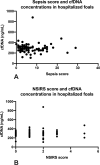Utility of cell-free DNA concentrations and illness severity scores to predict survival in critically ill neonatal foals
- PMID: 33901192
- PMCID: PMC8075268
- DOI: 10.1371/journal.pone.0242635
Utility of cell-free DNA concentrations and illness severity scores to predict survival in critically ill neonatal foals
Abstract
Plasma cell-free DNA (cfDNA) levels have been associated with disease and survival status in septic humans and dogs. To date, studies investigating cfDNA levels in association with critical illness in foals are lacking. We hypothesized that cfDNA would be detectable in the plasma of foals, that septic and sick-nonseptic foals would have significantly higher cfDNA levels compared to healthy foals, and that increased cfDNA levels would be associated with non-survival. Animals used include 80 foals of 10 days of age or less admitted to a tertiary referral center between January and July, 2020 were stratified into three categories: healthy (n = 34), sick non-septic (n = 11) and septic (n = 35) based on specific criteria. This was a prospective clinical study. Blood was collected from critically ill foals at admission or born in hospital for cfDNA quantification and blood culture. Previously published sepsis score (SS) and neonatal SIRS score (NSIRS) were also calculated. SS, NSIRS, blood culture status and cfDNA concentrations were evaluated to predict survival. Continuous variables between groups were compared using Kruskal-Wallis ANOVA with Dunn's post hoc test. Comparisons between two groups were assessed using the Mann-Whitney U-test or Spearman rank for correlations. The performance of cfDNA, sepsis score and NSIRS score to predict survival was assessed by receiver operator characteristic (ROC) curve analysis including area under the curve, sensitivity and specificity using cutoffs. Plasma cfDNA was detectable in all foals. No significant differences in cfDNA concentration were detected between healthy foals and septic foals (P = 0.65) or healthy foals and sick non-septic foals (P = 0.88). There was no significant association between cfDNA and culture status, SS, NSIRS or foal survival. SS (AUC 0.85) and NSIRS (AUC 0.83) were superior to cfDNA (AUC 0.64) in predicting survival. Although cfDNA was detectable in foal plasma, it offers negligible utility to diagnose sepsis or predict survival in critical illness in neonates.
Conflict of interest statement
The authors have declared that no competing interests exist.
Figures





Similar articles
-
Plasma adrenomedullin concentrations in critically ill neonatal foals.J Vet Intern Med. 2014 Jul-Aug;28(4):1294-300. doi: 10.1111/jvim.12358. Epub 2014 Apr 28. J Vet Intern Med. 2014. PMID: 24773029 Free PMC article.
-
Evaluation of updated sepsis scoring systems and systemic inflammatory response syndrome criteria and their association with sepsis in equine neonates.J Vet Intern Med. 2018 May;32(3):1185-1193. doi: 10.1111/jvim.15087. Epub 2018 Mar 26. J Vet Intern Med. 2018. PMID: 29582480 Free PMC article.
-
Plasma C-reactive protein and haptoglobin concentrations in critically ill neonatal foals.J Vet Intern Med. 2015 Mar-Apr;29(2):673-7. doi: 10.1111/jvim.12568. J Vet Intern Med. 2015. PMID: 25818221 Free PMC article.
-
Endocrine dysregulation in critically ill foals and horses.Vet Clin North Am Equine Pract. 2011 Apr;27(1):35-47. doi: 10.1016/j.cveq.2010.12.011. Vet Clin North Am Equine Pract. 2011. PMID: 21392652 Review.
-
Prognostic Indicators for Survival and Athletic Outcome in Critically Ill Neonatal Foals.Vet Clin North Am Equine Pract. 2015 Dec;31(3):615-28. doi: 10.1016/j.cveq.2015.09.006. Vet Clin North Am Equine Pract. 2015. PMID: 26612751 Review.
Cited by
-
Investigation of plasma cell-free DNA as a potential biomarker in horses.J Vet Diagn Invest. 2022 May;34(3):402-406. doi: 10.1177/10406387221078047. Epub 2022 Feb 15. J Vet Diagn Invest. 2022. PMID: 35168428 Free PMC article.
-
Plasma and Synovial Fluid Cell-Free DNA Concentrations Following Induction of Osteoarthritis in Horses.Animals (Basel). 2023 Mar 14;13(6):1053. doi: 10.3390/ani13061053. Animals (Basel). 2023. PMID: 36978592 Free PMC article.
-
Applying the concept of liquid biopsy to monitor the microbial biodiversity of marine coastal ecosystems.ISME Commun. 2022 Jul 27;2(1):61. doi: 10.1038/s43705-022-00145-0. ISME Commun. 2022. PMID: 37938655 Free PMC article.
-
Visualizing neutrophil extracellular traps in septic equine synovial and peritoneal fluid samples using immunofluorescence microscopy.J Vet Diagn Invest. 2023 Nov;35(6):751-760. doi: 10.1177/10406387231196552. Epub 2023 Sep 3. J Vet Diagn Invest. 2023. PMID: 37661696 Free PMC article.
-
Extracted Plasma Cell-Free DNA Concentrations Are Elevated in Colic Patients with Systemic Inflammation.Vet Sci. 2024 Sep 12;11(9):427. doi: 10.3390/vetsci11090427. Vet Sci. 2024. PMID: 39330806 Free PMC article.
References
Publication types
MeSH terms
Substances
LinkOut - more resources
Full Text Sources

